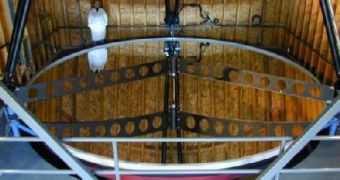A new proposition in the field of astronomical observations is getting mixed opinions. An American astronomer is proposing that we build a giant liquid-mirror telescope on the Moon, saying that it will be hundreds of times more accurate and sensitive than even the Hubble Space Telescope.
Roger Angel, a member of the National Academy of Sciences, a MacArthur Fellow and a Fellow of the Royal Society, is testing the possibility of building such a device on the Moon. He says it will have to use a rotating observation dish made of liquid and that it will be the largest in the world, although the phrase "in the world" will no longer apply here.
"It's an idea that's been around, and we decided to flesh it out," Angel says. There are a few examples of the applications being successfully applied on Earth, like the Large Zenith Telescope (LZT). Although it can only look straight up, having no possibility to change its orientation, its simplified setup permits the use of a mirror consisting of a smoothly spinning pan filled with liquid mercury. Such a mirror can be made much larger than a conventional mirror, greatly increasing light collecting ability.
The scientist says that on the Moon, where there's no atmosphere and a gravity 6 times weaker than on Earth, a telescope using a mirror of 100 meters in diameter would collect 1,736 times more light than the Hubble. The fact that it would be larger than two side-by-side football fields can only add to its observation capabilities.
Scientists have not only taken his proposition seriously, not making fun of it at all, but they even consider a 20-meter wide telescope being technologically possible and still able to be 70 times more sensitive than Hubble and to detect objects 100 times fainter.
"At first, it sort of sounds like a crazy idea," says Paul Hickson of the University of British Columbia, one of two Canadian LMT experts who collaborated with Angel on the study. "But when you go through it in some detail, you realize it could actually work."
The money issue will definitely not be a problem for NASA, even if the lunar telescope will come with a $4.5 billion price tag.

 14 DAY TRIAL //
14 DAY TRIAL //